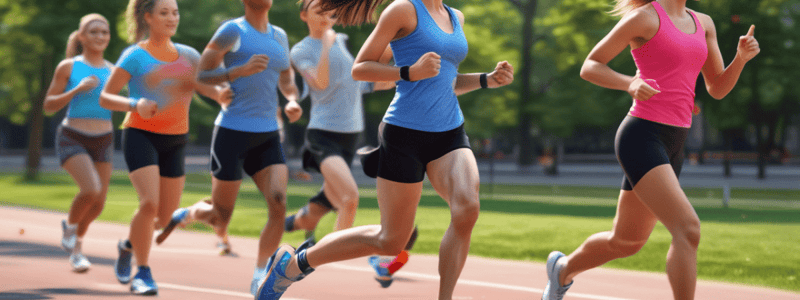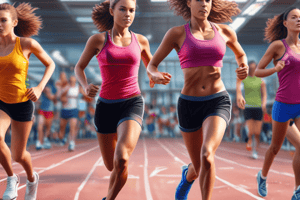Podcast
Questions and Answers
What is a key reason for the increase in female participation in exercise, physical activity, and sport?
What is a key reason for the increase in female participation in exercise, physical activity, and sport?
- Title IX legislation passed in 1972
- Knowledge of the health benefits of exercise and physical activity (correct)
- Female-specific reproductive functions
- Societal prejudices against females participating in sports
What female-specific issue related to exercise is highlighted in the text?
What female-specific issue related to exercise is highlighted in the text?
- Sociocultural barriers
- Neuromuscular strength
- Hormonal imbalance
- Orthopedic injuries (correct)
Which factor contributes to females being at a higher risk of ACL injury compared to males?
Which factor contributes to females being at a higher risk of ACL injury compared to males?
- Sociocultural influences
- Hormonal balance
- Anatomic differences like the Q angle (correct)
- Lack of core stability
What is the concept of the female athlete triad primarily concerned with?
What is the concept of the female athlete triad primarily concerned with?
What are the three interrelated spectrums described in the current ACSM definition of the female athlete triad?
What are the three interrelated spectrums described in the current ACSM definition of the female athlete triad?
What is the proposed mechanism of menstrual disturbances associated with vigorous exercise and/or low energy intake?
What is the proposed mechanism of menstrual disturbances associated with vigorous exercise and/or low energy intake?
What is oligomenorrhea?
What is oligomenorrhea?
What is the prevalence of amenorrhea in the general population?
What is the prevalence of amenorrhea in the general population?
What is the definition of osteoporosis according to the text?
What is the definition of osteoporosis according to the text?
What is the definition of osteopenia according to the text?
What is the definition of osteopenia according to the text?
What is the prevalence of amenorrhea among elite runners?
What is the prevalence of amenorrhea among elite runners?
What is the prevalence of amenorrhea among professional ballet dancers?
What is the prevalence of amenorrhea among professional ballet dancers?
What is the proposed cause of the association between intense training and menstrual cycle changes?
What is the proposed cause of the association between intense training and menstrual cycle changes?
The Q angle, referring to the quadriceps angle, is an anatomical factor that increases the risk of anterior cruciate ligament (ACL) injury in females compared to males.
The Q angle, referring to the quadriceps angle, is an anatomical factor that increases the risk of anterior cruciate ligament (ACL) injury in females compared to males.
The traditional definition of the female athlete triad included disordered eating, amenorrhea, and low bone mineral density, but the current ACSM description involves three interrelated spectrums: (1) optimal energy availability to low energy availability (with or without eating disorders), (2) menstrual function, and (3) bone mineral density.
The traditional definition of the female athlete triad included disordered eating, amenorrhea, and low bone mineral density, but the current ACSM description involves three interrelated spectrums: (1) optimal energy availability to low energy availability (with or without eating disorders), (2) menstrual function, and (3) bone mineral density.
The passage suggests that the increase in female participation in exercise, physical activity, and sport over the past several decades is primarily due to the passage of Title IX legislation in 1972, which reduced societal prejudices and obstacles for females participating in sports.
The passage suggests that the increase in female participation in exercise, physical activity, and sport over the past several decades is primarily due to the passage of Title IX legislation in 1972, which reduced societal prejudices and obstacles for females participating in sports.
The text implies that the risk factors for anterior cruciate ligament (ACL) injury in females are multi-factorial, involving anatomic, environmental, hormonal, and biomechanical factors.
The text implies that the risk factors for anterior cruciate ligament (ACL) injury in females are multi-factorial, involving anatomic, environmental, hormonal, and biomechanical factors.
According to the passage, females generally respond to training and exercise differently from males, with the exception of reproductive function (menstrual cycle, pregnancy) and orthopedic injury risk.
According to the passage, females generally respond to training and exercise differently from males, with the exception of reproductive function (menstrual cycle, pregnancy) and orthopedic injury risk.
Optimal bone health is the result of a precise synchronization of hormonal events in the hypothalamus, anterior pituitary gland, and ovaries.
Optimal bone health is the result of a precise synchronization of hormonal events in the hypothalamus, anterior pituitary gland, and ovaries.
The prevalence of amenorrhea in the general population is higher than the prevalence in women engaged in vigorous exercise training.
The prevalence of amenorrhea in the general population is higher than the prevalence in women engaged in vigorous exercise training.
Oligomenorrhea and amenorrhea are interchangeable terms that both refer to the complete cessation of the menstrual cycle.
Oligomenorrhea and amenorrhea are interchangeable terms that both refer to the complete cessation of the menstrual cycle.
Osteoporosis is defined as a bone mineral density (BMD) that is less than or equal to 1 standard deviation below the average BMD for a young sex- and race-matched reference population.
Osteoporosis is defined as a bone mineral density (BMD) that is less than or equal to 1 standard deviation below the average BMD for a young sex- and race-matched reference population.
Low energy availability can lead to amenorrhea, which has been observed since the 1950s to be associated with intense training.
Low energy availability can lead to amenorrhea, which has been observed since the 1950s to be associated with intense training.
Exercise has no impact on promoting psychological and cognitive well-being in older adults.
Exercise has no impact on promoting psychological and cognitive well-being in older adults.
The number of older adults in the U.S. is expected to decrease by 2040 according to the U.S. Census Bureau data.
The number of older adults in the U.S. is expected to decrease by 2040 according to the U.S. Census Bureau data.
Loss of independence in older adults can lead to catastrophic consequences.
Loss of independence in older adults can lead to catastrophic consequences.
Osteoporosis is a condition that strengthens muscle, bone, and connective tissue in older adults.
Osteoporosis is a condition that strengthens muscle, bone, and connective tissue in older adults.
By 2030, one in every five U.S. residents is projected to be of retirement age.
By 2030, one in every five U.S. residents is projected to be of retirement age.
The $\text{VO}_{2\max}$ decline with age is more rapid after age 60-70 years compared to earlier decades.
The $\text{VO}_{2\max}$ decline with age is more rapid after age 60-70 years compared to earlier decades.
Muscle mass decreases by approximately 15-25% per decade after age 30.
Muscle mass decreases by approximately 15-25% per decade after age 30.
Biological age is considered a better indicator of an individual's ability to engage in physical activity than chronological age.
Biological age is considered a better indicator of an individual's ability to engage in physical activity than chronological age.
The sudden decline in physical function observed in older adults is always attributed to the effects of deconditioning or disease.
The sudden decline in physical function observed in older adults is always attributed to the effects of deconditioning or disease.
Individuals classified as 'oldest old' are 95 years of age or older.
Individuals classified as 'oldest old' are 95 years of age or older.
The $\text{VO}_{2\max}$ decline with age is less rapid after age 70 compared to earlier decades.
The $\text{VO}_{2\max}$ decline with age is less rapid after age 70 compared to earlier decades.
The traditional definition of the female athlete triad included disordered eating, amenorrhea, and osteopenia.
The traditional definition of the female athlete triad included disordered eating, amenorrhea, and osteopenia.
The Q angle, referring to the quadriceps angle, is an anatomical factor that decreases the risk of anterior cruciate ligament (ACL) injury in females compared to males.
The Q angle, referring to the quadriceps angle, is an anatomical factor that decreases the risk of anterior cruciate ligament (ACL) injury in females compared to males.
The prevalence of amenorrhea in the general population is lower than the prevalence in women engaged in vigorous exercise training.
The prevalence of amenorrhea in the general population is lower than the prevalence in women engaged in vigorous exercise training.
Low energy availability is proposed as the cause of the association between intense training and menstrual cycle changes.
Low energy availability is proposed as the cause of the association between intense training and menstrual cycle changes.
Flashcards are hidden until you start studying




